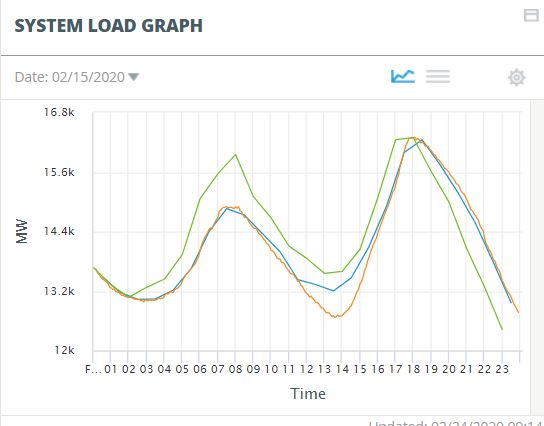Most solar power in New England is, like the PV panels on my roof, “behind the meter”. That means the production is not visible to ISO-NE, the folks who run our six-state power grid, unlike every-five-minute electricity production from Seabrook Station or gas-fired power plants or hydropower dams. ISO-NE sees behind-the-meter solar as reduced demand rather than increased production, which complicates their ability to manage the grid.
The last couple of weeks have been very good for solar, with lots of sun and cold temperatures (electronics is more efficient when it’s cold). Yet the maximum amount of solar production – that is, in front of the meter – I’ve seen has been about 170 MW, whereas ISO-NE estimates that there’s more than 3,000 MW of behind-the-meter solar in the region.
These two screen grabs of all-day charts from ISO-NE show what this means. The yellow/orangey line is the power production needed during the day; the blue and green lines involve forecasts.
This chart shows a cloudy weekday. Peak demand is in the evening, when everybody comes home from work, and the low point is around 3 a.m. That has been the standard curve for a long time.

Now look at this chart from on a sunny Saturday. That dip in the middle of the day is mostly caused by behind-the-meter solar reducing demand.

The remarkable thing is that the lowest output of the 24-hour period came in mid-afternoon instead of the middle of the night – that never happened until rooftop solar came along.
You can see why this is giving grid planners fits and is throwing a monkey wrench into the finances of power plants that were built with the assumption that the top curve would continue to be the norm. It’s a brave new world out there for electricity production.

 Return to the Concord Monitor
Return to the Concord Monitor